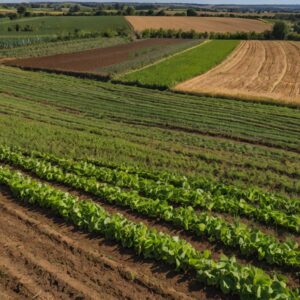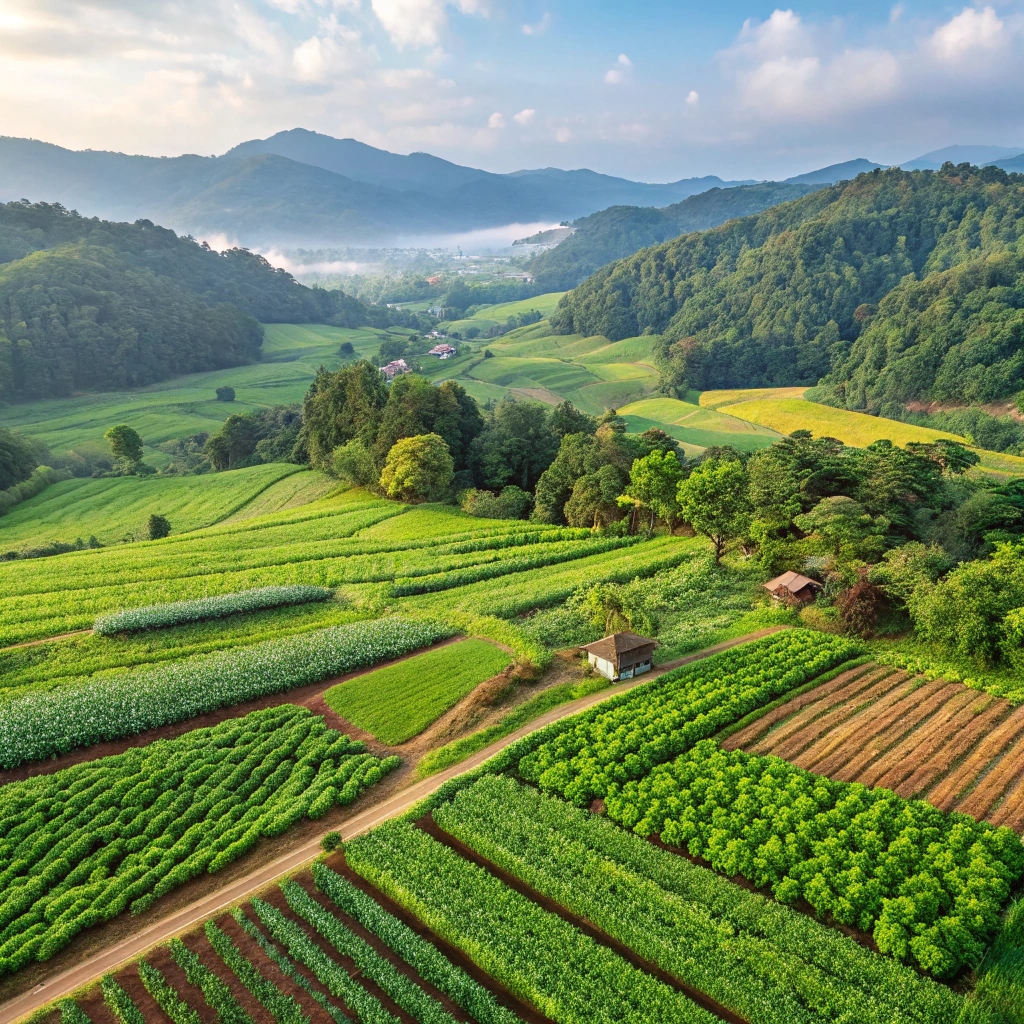Did you know that your food choices have more power than ever before?
In recent years, we’ve come to realize the profound impact our food system has on not only our health but also the planet. We’re talking about some serious issues here – climate change, soil degradation, and biodiversity loss.
But what if I told you there’s a way to revolutionize the way we farm, feed ourselves, and protect our planet at the same time?
It starts with understanding how regenerative agriculture can transform your relationship with food.
Soaking Up Knowledge – Understanding the Basics of Regenerative Agriculture
Regenerative agriculture is more than just a way of farming, it’s a way to heal the planet. It starts with understanding how your food system works and where it falls short.
When you think about what makes up the basics of regenerative agriculture, consider that these methods prioritize soil health as their foundation. That means improving the structure of soil through crop rotations, adding organic matter like compost and manure, and avoiding synthetic fertilizers which can harm the environment in many ways.
These practices help to increase biodiversity by incorporating different plant species into farming systems. This increases ecosystem services such as pollination, pest control, and nutrient cycling. It also helps reduce greenhouse gas emissions by promoting better water management techniques.
A healthy food system will give you a more stable supply of nutrients that benefit people’s health. Moreover, the planet itself will have improved soil quality which reduces erosion and prevents landslides from occurring when it rains or snows.
Finding the Sweet Spot – Balancing Ecosystems for Sustainable Farming
Regenerative agriculture requires harmony between ecology and production – it’s all about making the most of nature while minimizing harm. By understanding how different practices affect each other, farmers can create an environment that supports healthy plants and reduces environmental stressors.
Agroecosystem mapping is a powerful tool for finding this sweet spot. This involves creating detailed maps of relationships between components like soil quality, water flow, vegetation types, and crop cycles. By visualizing these connections and identifying areas where negative effects are occurring or positive ones are happening, farmers can make informed decisions that promote balanced ecosystems.
For example, researchers have used agroecosystem mapping to identify hotspots in agriculture that require special attention. In the Maasai Mara region of Kenya, this approach has helped reduce soil erosion by 50% and increased biodiversity by 30%. By combining data from sensors like satellite imaging and drone technology with traditional knowledge, farmers can create more resilient food systems.
Practices like no-till or reduced tillage farming can also play a crucial role in achieving balance. This approach reduces soil disturbance while promoting beneficial microbial growth and increasing water retention capabilities of the soil. In some regions, no-till farming has helped reduce greenhouse gas emissions by up to 75% compared to conventional methods.
Balancing ecological diversity with productivity is key to creating more resilient food systems. By implementing strategies like agroecosystem mapping, no-till farming, and crop rotation planning, farmers can create a healthier planet for future generations. Research shows that regenerative agriculture can help address climate change by sequestering carbon in soils, improving soil health through reduced tilling or conservation tillage practices.
By taking these steps forward-thinking farmers can make informed decisions that promote balanced ecosystems while minimizing environmental stressors. With the right tools and knowledge, anyone can find their sweet spot between ecology and production – a harmony of nature that benefits both people and the planet.
Nutrient-Rich Soil Secrets
 A healthy food system relies on fertile soil, which can be improved through regenerative agriculture practices. Did you know that a single acre of well-managed land can produce 10 times more food than an acre under conventional farming methods? This staggering statistic highlights the significance of soil health in ensuring global food security.
A healthy food system relies on fertile soil, which can be improved through regenerative agriculture practices. Did you know that a single acre of well-managed land can produce 10 times more food than an acre under conventional farming methods? This staggering statistic highlights the significance of soil health in ensuring global food security.
When your soil is rich in essential nutrients, it allows crops to thrive, reducing the need for chemical fertilizers and pesticides. A diverse ecosystem with beneficial microbes plays a vital role in this process. Beneficial microbes like Rhizobia help fix nitrogen in soils by converting atmospheric N2 into ammonia, allowing plants to absorb the necessary nutrients.
The addition of compost or manure can significantly improve soil structure, increasing its water-holding capacity and creating an environment that supports healthy plant growth. This diverse microbial community helps to decompose organic matter, fix nutrients, and synthesize essential compounds for plant development. For instance, mycorrhizal fungi form symbiotic relationships with plant roots, enhancing nutrient uptake and promoting a resilient ecosystem.
By adopting regenerative agriculture practices like adding compost or manure, you can significantly boost your soil’s water-holding capacity. This not only benefits crops but also reduces the risk of droughts and floods by maintaining healthy soil moisture levels. The diverse microbial population that develops in such soils is better equipped to break down organic matter, recycle nutrients, and promote overall ecosystem health.
To give you a better idea of how regenerative agriculture can make a real difference, consider this example: A study published in the Journal of Soil Science found that farmers who implemented compost amendments on their fields saw significant improvements in soil carbon sequestration. This not only reduced greenhouse gas emissions but also increased crop yields and improved water quality.
A healthy food system relies on fertile soil to support crop growth. By taking steps to improve your soil’s structure, nutrient levels, and overall resilience, you’re contributing to a more sustainable food future for generations to come.
Biodiversity Boosters How Microorganisms Help Your Food Systems Thrive
Microorganisms play a significant role in unlocking a healthier planet by adding diversity and fertility to your soil through nitrogen fixation, phosphorus production, and magnesium release. They break down organic matter like dead plants, acting as carbon sinks in the ecosystem.
In fact, microorganisms can increase nitrogen fixation by up to 30% through symbiotic relationships with plant roots. This not only supports healthy plant growth but also sequesters carbon in soils for a more stable climate.
By producing phosphorus and releasing magnesium, these tiny helpers improve soil structure and fertility, making it easier for water to penetrate the earth. For instance, mycorrhizal fungi can increase nutrient availability by up to 50%, leading to healthier plants and better crop yields.
But that’s not all – microorganisms also impact ecosystem processes. By breaking down organic matter, they create a nutrient-rich environment that supports plant growth while sequestering carbon in soils. This is especially important for farmers looking to reduce their environmental footprint and promote sustainable agriculture practices.
So why do we need microorganisms? Consider this: every bite of food you take contains the result of countless microbial interactions with soil. By embracing these tiny helpers, we can revolutionize our approach to food systems and create a healthier planet – one soil type at a time.
Cycles and Cycles Managing Water in Regenerative Agriculture
Water management is a critical component of regenerative agriculture, with far-reaching implications for food systems and ecosystem health. If left unmanaged, droughts and floods can decimate crops and disrupt delicate ecosystems.
Crop rotation with native species like alfalfa or clover helps retain soil moisture and reduce erosion, while drip irrigation methods conserve water while maintaining crop health. For instance, farmers in California use precision agriculture to deliver water directly to the roots of plants via drip tubes, significantly reducing evaporation and runoff. Similarly, mulching and cover cropping help prevent soil loss by retaining moisture through their thick layers.
Understanding the hydrological cycle is vital for making informed decisions about irrigation schedules that balance crop needs with ecosystem health. The cycle involves four main stages: water evaporates from the land as heat, condenses into clouds to form rain or snow, falls back to Earth as precipitation, and then seeps into groundwater recharge. By grasping this concept, farmers can tailor their irrigation systems to maximize water retention while minimizing waste.
Implementing strategies like rainwater harvesting systems or grey water reuse programs reduces reliance on municipal sources and minimizes waste. For example, a farmer in Australia uses an efficient drip irrigation system that captures and stores rainwater for use during dry spells. This approach not only conserves potable water but also helps maintain healthy soil moisture levels.
Farmers can adopt regenerative agriculture practices like crop rotation with drought-tolerant species to optimize their water usage while maintaining ecosystem balance. By embracing these techniques, farmers will be well-equipped to manage the complex cycles of water in regenerative agriculture and ensure a more resilient food system for future generations.
Livestock as Guardians – Understanding the Role of Animals in Healthy Ecosystems
Livestock play a vital role in maintaining ecological balance and promoting soil health, making them guardians that benefit our planet’s future generations. To create pathways for water movement, grazing animals like cattle, goats, and sheep move their feet in a pattern that helps to reduce erosion. This action also creates micro-channels through which water can infiltrate the soil more effectively.
For example, studies have shown that allowing livestock to graze on pastures with diverse vegetation can increase organic matter in soils by up to 30%. Additionally, grazing animals contribute to nutrient cycling by depositing waste back into the ecosystem. This process not only reduces fertilizer needs but also helps maintain soil structure and fertility.
By incorporating native grasses like buffalo grass or prairie clover into your pasture mix, you can attract beneficial insects that pollinate and decompose organic matter, promoting healthy soil biota. Implementing rotational grazing systems can help create diverse pastures that promote soil health and biodiversity. In doing so, these practices not only benefit the environment but also provide a sustainable source of fresh produce for farm families.
Incorporating livestock into your land management strategy requires careful planning to avoid overgrazing or underutilization of pastureland. However, when done correctly, grazing animals can become an integral component of regenerative agriculture, working in harmony with nature to create resilient ecosystems that thrive.
Eco-Friendly Farming Practices That Save You Money
 Implementing certain agricultural strategies can significantly reduce farming expenses while maintaining a sustainable agriculture system. A study by the Rodale Institute found that rotating legume crops with non-legumes increases yields by up to 20% and reduces fertilizer costs, making it an attractive option for farmers looking to cut their expenses without sacrificing productivity.
Implementing certain agricultural strategies can significantly reduce farming expenses while maintaining a sustainable agriculture system. A study by the Rodale Institute found that rotating legume crops with non-legumes increases yields by up to 20% and reduces fertilizer costs, making it an attractive option for farmers looking to cut their expenses without sacrificing productivity.
Crop rotation is one such strategy, which involves planting different types of crops in a specific order. This approach breaks disease cycles and improves soil fertility, allowing you to reduce your reliance on synthetic fertilizers that contain harsh chemicals harmful to the environment. For instance, rotating cereals with legumes can improve nitrogen fixation, while alternating between Brassicas and solanaceous crops helps manage pests.
Another cost-effective strategy is maintaining healthy crop yields through Integrated Pest Management (IPM) techniques. By identifying and controlling pests organically, such as using beneficial insects or physical barriers instead of chemical pesticides, you can prevent costly losses due to insect damage. This approach not only reduces expenses but also promotes ecosystem services essential for food security in future generations.
To maximize efficiency, adopt efficient irrigation methods like drip irrigation systems that deliver nutrients directly to the roots without leaving excess water on the surface to evaporate. These systems have been shown to use up to 75% less water than traditional sprinkler irrigation while maintaining yields.
Regenerative agriculture is not just about environmental sustainability; it also provides an opportunity for economic benefits through cost reduction and increased crop yields. A study by the USDA found that organic farms in California experienced a remarkable 25% reduction in water use and costs through targeted drip irrigation, which translated to significant revenue increases.
To implement these eco-friendly practices, consider the following steps:
- Identify your crop water requirements using soil moisture sensors.
- Choose a dripline system with precise nozzle spacing and flow rates that match your specific climate conditions.
- Adjust the timing of watering to match optimal growing conditions, which may involve incorporating mulch or cover crops.
By embracing these strategies, farmers can reduce their expenses while maintaining a more sustainable approach to agriculture, ultimately securing their future prosperity.
Integrating Technology to Enhance Sustainable Food Systems
Technology is ushering in a new era of regenerative agriculture, taking it from sustainable to revolutionary. Precision farming tools and AI-powered systems are amplifying farmers’ abilities to create healthier ecosystems and more resilient food systems.
Precision agriculture is transforming the way crops are planted, watered, and harvested. For instance, drones equipped with advanced sensors can analyze soil composition in real-time, reducing fertilizer application by 25% due to hyper-local monitoring of nutrient levels. In a similar vein, one farm implemented an AI-powered weather forecasting system that optimized irrigation practices by up to 30%, saving thousands of gallons per acre.
Imagine having a supercomputer for your farm – this is exactly what precision agriculture provides. By combining data from multiple sources like drones, satellite imaging, and sensor networks, farmers can identify optimal planting schedules and reduce waste. This results in higher yields while minimizing environmental impact.
Artificial intelligence (AI) is another game-changer in crop monitoring and prediction. AI-powered algorithms analyze vast amounts of weather patterns, soil health data, pest behavior, and more to flag potential issues before they become problems. For example, a recent study showed that AI-based crop modeling improved corn yields by 15% in the Midwest United States.
However, there’s also a flip side: bias in data analysis can lead to misinformed decisions if not addressed properly. Moreover, an over-reliance on technology may cause farmers to neglect their intuition and judgment – essential qualities for adaptability in dynamic farming environments. Nonetheless, AI-enhanced agriculture has the potential to save crops from devastating losses estimated at billions of dollars annually.
By embracing these cutting-edge technologies, farmers can refine agricultural practices that balance efficiency with environmental stewardship. For instance, advanced irrigation systems using weather forecasts or soil sensors have been shown to reduce water consumption by up to 30%. Furthermore, precision agriculture enables precise control over planting schedules and harvesting techniques, helping minimize waste and maximize yields.
In the long run, technology-enhanced agricultural planning will help farmers optimize their resource allocation. By leveraging cutting-edge tools like satellite imaging and sensor networks, they can make data-driven decisions about land use that promote efficient crop distribution across available resources. As a result of these advancements in precision agriculture and AI-based farm management we are seeing an increase adoption rates for sustainable farming practices which is likely to have long term environmental benefits
Biodiversity and Resilience How Regenerative Agriculture And Ecosystems
 Biodiversity has taken a drastic hit due to industrial agriculture’s relentless pursuit of yield and efficiency. The consequences are alarming, with natural systems fragmenting in response. This loss erodes resilience as ecosystems struggle to cope.
Biodiversity has taken a drastic hit due to industrial agriculture’s relentless pursuit of yield and efficiency. The consequences are alarming, with natural systems fragmenting in response. This loss erodes resilience as ecosystems struggle to cope.
But what exactly is biodiversity? It’s not just about having an abundance of plants and animals; it’s also about the diversity within each species itself. Take wheat, for instance – did you know there are over 70,000 known varieties worldwide? These differences can be game-changers when they occur naturally in nature.
As biodiversity dwindles, so does resilience. The risk of disease outbreaks skyrockets because many organisms share similar characteristics. For example, a decrease in bees or butterflies can mean frequent crop failures – these insects are essential for pollination!
But it’s not just about crops; ecosystems themselves become vulnerable when there’s only one type of plant species around. When the natural state is disturbed, like with wheat, disease can wreak havoc.
The decline of biodiversity and resilience is a vicious cycle: reduce loss to promote growth. To break this cycle, we must act now. By supporting local conservation efforts and choosing sustainable farming practices, you’re taking a crucial step towards preserving ecosystems that will help prevent an even greater loss down the road.
The Impact on Local Food Systems
When crops lose genetic diversity, they become more susceptible to disease and pests. This is particularly concerning for global food security – with one in nine people facing hunger worldwide. By supporting sustainable agriculture and preserving natural ecosystems, we can safeguard against these risks.
Consequences for Ecosystems
As biodiversity declines, entire ecosystems start to crumble. Deforestation, overfishing, and pollution all take their toll on the environment. The economic costs are staggering – from lost ecosystem services to healthcare expenses related to environmental degradation.
Take Action!
Reducing our ecological footprint is not just a moral imperative; it’s essential for preserving life on Earth.
By making conscious choices in your daily life, you can contribute significantly towards saving biodiversity and promoting resilience:
- Support local farmers who use sustainable practices
- Choose organic or locally sourced produce when possible
- Plant native species in your community garden to boost biodiversity
Join the movement to protect ecosystems that will help prevent an even greater loss down the road. By working together, we can build a more resilient world for all life on Earth.
Biodiversity’s decline is not just a numbers game; it affects us directly. By understanding its significance and taking action now, you can contribute to preserving natural systems that support our food security and well-being. Every small step counts – take yours today!
Regenerative Ag for Climate Change Mitigation Strategies
Regenerative agriculture has a vital role to play in addressing climate change through its impact on soil health and human well-being.
The key lies in understanding how farming methods influence our environment and, by extension, ourselves. One crucial strategy is no-till or reduced tillage. By minimizing disturbance of the soil surface, crops develop deeper root systems that improve drought tolerance and increase water retention. No-till farming reduces greenhouse gas emissions by up to 50%, while also improving soil carbon sequestration and reducing erosion.
Crop rotation with legumes takes it a step further. Legume-based rotations have been shown to increase nitrogen-fixing bacteria in soils, enhancing crop yields and mitigating the environmental impact of fertilizer use. By incorporating these practices into farming systems, farmers can experience significant benefits: increased productivity without relying on synthetic fertilizers; improved soil health; and enhanced biodiversity.
Another powerful tool is to cover crops. These plantings not only provide a habitat for beneficial insects but also help retain soil moisture, prevent erosion, and support nutrient cycling. This reduces runoff and sedimentation in waterways, benefiting nearby ecosystems. Moreover, incorporating cover crops into farming systems has been shown to increase topsoil organic matter, reducing erosion and supporting beneficial insect populations.
By adopting these strategies together with other sustainable practices like agroforestry or permaculture design, farmers can enhance the overall resilience of their systems. This could include setting up livestock-grassland rotations that mimic natural patterns by mimicking grazing ecosystems and reduce methane emissions from ruminant animals which is equivalent to around 40% less emissions compared to non-rotational grazing.
Regenerative agriculture can increase soil organic carbon content by 2-5% per year, equivalent to removing up to 10 million tons of CO2 from the atmosphere annually. This not only helps counteract climate change but also contributes significantly towards human well-being through enhanced nutrition and a decrease in respiratory health issues associated with particulate pollution.
Let’s explore these concepts further into How Regenerative Agriculture Can Mitigate Climate Change or Soils: A Key Strategy for a Healthier Planet
Revolutionizing Food Systems: The Power of Regenerative Agriculture in Unlocking a Healthier Planet for Future Generations
Just Imagine A World Where Every Bite is a Vote for Sustainability
The power of regenerative agriculture lies not only in its ability to increase crop yields and promote ecosystem services, but also in its capacity to shift the way we think about food. By adopting regenerative practices, farmers can sequester carbon from the atmosphere, improve soil health, and support biodiversity – creating a more resilient food system that benefits both people and the planet.
The potential for regenerative agriculture is vast: not only can it help mitigate climate change by removing CO2 from the atmosphere but also contribute to global food security by increasing crop resilience. Moreover, adopting regenerative practices requires less external input which will lead to saving on costs of production thus making food more affordable and sustainable. By supporting farmers who adopt these methods we can create a healthier planet for future generations.
So take action today – join the movement towards regenerative agriculture and start growing your own garden with intention, patience, knowledge and love to become an integral part of creating a better world that’s good enough to live in by every bite.




